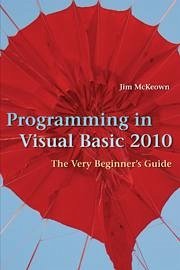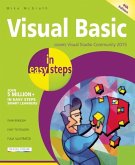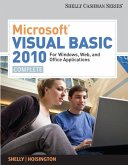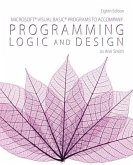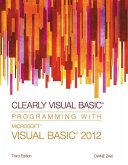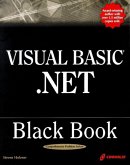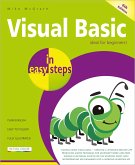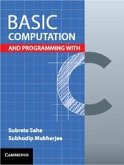- Broschiertes Buch
- Merkliste
- Auf die Merkliste
- Bewerten Bewerten
- Teilen
- Produkt teilen
- Produkterinnerung
- Produkterinnerung
An introduction to programming using Microsoft's Visual Basic.NET 2010 for anyone with little or no programming experience.
Andere Kunden interessierten sich auch für
![Visual Basic in Easy Steps Visual Basic in Easy Steps]() Mike McgrathVisual Basic in Easy Steps12,99 €
Mike McgrathVisual Basic in Easy Steps12,99 €![Microsoft Visual Basic 2010 for Windows, Web, and Office Applications Microsoft Visual Basic 2010 for Windows, Web, and Office Applications]() Gary B ShellyMicrosoft Visual Basic 2010 for Windows, Web, and Office Applications203,99 €
Gary B ShellyMicrosoft Visual Basic 2010 for Windows, Web, and Office Applications203,99 €![Microsoft Visual Basic Programs to Accompany Programming Logic and Design Microsoft Visual Basic Programs to Accompany Programming Logic and Design]() Jo Ann SmithMicrosoft Visual Basic Programs to Accompany Programming Logic and Design197,99 €
Jo Ann SmithMicrosoft Visual Basic Programs to Accompany Programming Logic and Design197,99 €![Clearly Visual Basic: Programming with Microsoft Visual Basic 2012 Clearly Visual Basic: Programming with Microsoft Visual Basic 2012]() Diane ZakClearly Visual Basic: Programming with Microsoft Visual Basic 2012200,99 €
Diane ZakClearly Visual Basic: Programming with Microsoft Visual Basic 2012200,99 €![Visual Basic .Net Black Book Visual Basic .Net Black Book]() Steve HolznerVisual Basic .Net Black Book44,99 €
Steve HolznerVisual Basic .Net Black Book44,99 €![Visual Basic in Easy Steps Visual Basic in Easy Steps]() Mike McgrathVisual Basic in Easy Steps13,99 €
Mike McgrathVisual Basic in Easy Steps13,99 €![Basic Computation and Programming with C Basic Computation and Programming with C]() Subrata SahaBasic Computation and Programming with C98,99 €
Subrata SahaBasic Computation and Programming with C98,99 €-
-
-
An introduction to programming using Microsoft's Visual Basic.NET 2010 for anyone with little or no programming experience.
Produktdetails
- Produktdetails
- Verlag: Cambridge University Press
- Seitenzahl: 784
- Erscheinungstermin: 29. März 2010
- Englisch
- Abmessung: 251mm x 178mm x 38mm
- Gewicht: 1225g
- ISBN-13: 9780521721110
- ISBN-10: 0521721113
- Artikelnr.: 28244786
- Herstellerkennzeichnung
- Libri GmbH
- Europaallee 1
- 36244 Bad Hersfeld
- gpsr@libri.de
- Verlag: Cambridge University Press
- Seitenzahl: 784
- Erscheinungstermin: 29. März 2010
- Englisch
- Abmessung: 251mm x 178mm x 38mm
- Gewicht: 1225g
- ISBN-13: 9780521721110
- ISBN-10: 0521721113
- Artikelnr.: 28244786
- Herstellerkennzeichnung
- Libri GmbH
- Europaallee 1
- 36244 Bad Hersfeld
- gpsr@libri.de
Dr Jim McKeown has spent more than 20 years at Dakota State University, where he is an Assistant Professor. He currently teaches programming, computer hardware, software testing, and computer applications. He received a master's degree in computer education from Columbia University and holds a Ph.D. in instructional design from the University of Iowa. He has contributed several articles to the Journal for Computing in Small Colleges as well as various other publications.
1. Fundamentals of design and programming
starting from scratch; 2. Variable and constants
a place for everything and everything in its place; 3. Writing programs
first you walk, then you run; 4. Writing programs II
more controls and new logic; 5. Using if and case
decisions, decisions, decisions; 6. Loops
once is not enough; 7. Procedures and functions
divide and conquer; 8. Writing programs III
tying it all together, so far; 9. File i/o
files and records and fields, oh my!; 10. Arrays and structures
organizing data; 11. Events and more controls
tips and tricks for programming; 12. Objects and classes
objects are in a class by themselves; 13. Graphics
the visual (and audio) side of Visual Basic; 14. LINQ to SQL
the world runs on databases; 15. Crystal reports
tying databases to output.
starting from scratch; 2. Variable and constants
a place for everything and everything in its place; 3. Writing programs
first you walk, then you run; 4. Writing programs II
more controls and new logic; 5. Using if and case
decisions, decisions, decisions; 6. Loops
once is not enough; 7. Procedures and functions
divide and conquer; 8. Writing programs III
tying it all together, so far; 9. File i/o
files and records and fields, oh my!; 10. Arrays and structures
organizing data; 11. Events and more controls
tips and tricks for programming; 12. Objects and classes
objects are in a class by themselves; 13. Graphics
the visual (and audio) side of Visual Basic; 14. LINQ to SQL
the world runs on databases; 15. Crystal reports
tying databases to output.
1. Fundamentals of design and programming
starting from scratch; 2. Variable and constants
a place for everything and everything in its place; 3. Writing programs
first you walk, then you run; 4. Writing programs II
more controls and new logic; 5. Using if and case
decisions, decisions, decisions; 6. Loops
once is not enough; 7. Procedures and functions
divide and conquer; 8. Writing programs III
tying it all together, so far; 9. File i/o
files and records and fields, oh my!; 10. Arrays and structures
organizing data; 11. Events and more controls
tips and tricks for programming; 12. Objects and classes
objects are in a class by themselves; 13. Graphics
the visual (and audio) side of Visual Basic; 14. LINQ to SQL
the world runs on databases; 15. Crystal reports
tying databases to output.
starting from scratch; 2. Variable and constants
a place for everything and everything in its place; 3. Writing programs
first you walk, then you run; 4. Writing programs II
more controls and new logic; 5. Using if and case
decisions, decisions, decisions; 6. Loops
once is not enough; 7. Procedures and functions
divide and conquer; 8. Writing programs III
tying it all together, so far; 9. File i/o
files and records and fields, oh my!; 10. Arrays and structures
organizing data; 11. Events and more controls
tips and tricks for programming; 12. Objects and classes
objects are in a class by themselves; 13. Graphics
the visual (and audio) side of Visual Basic; 14. LINQ to SQL
the world runs on databases; 15. Crystal reports
tying databases to output.

